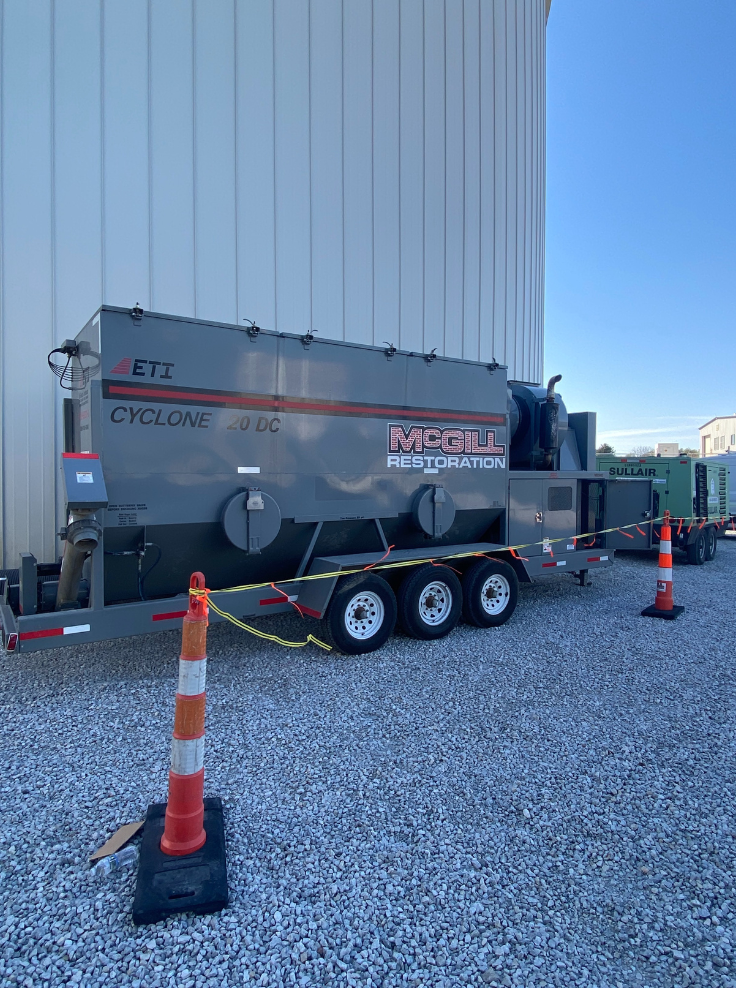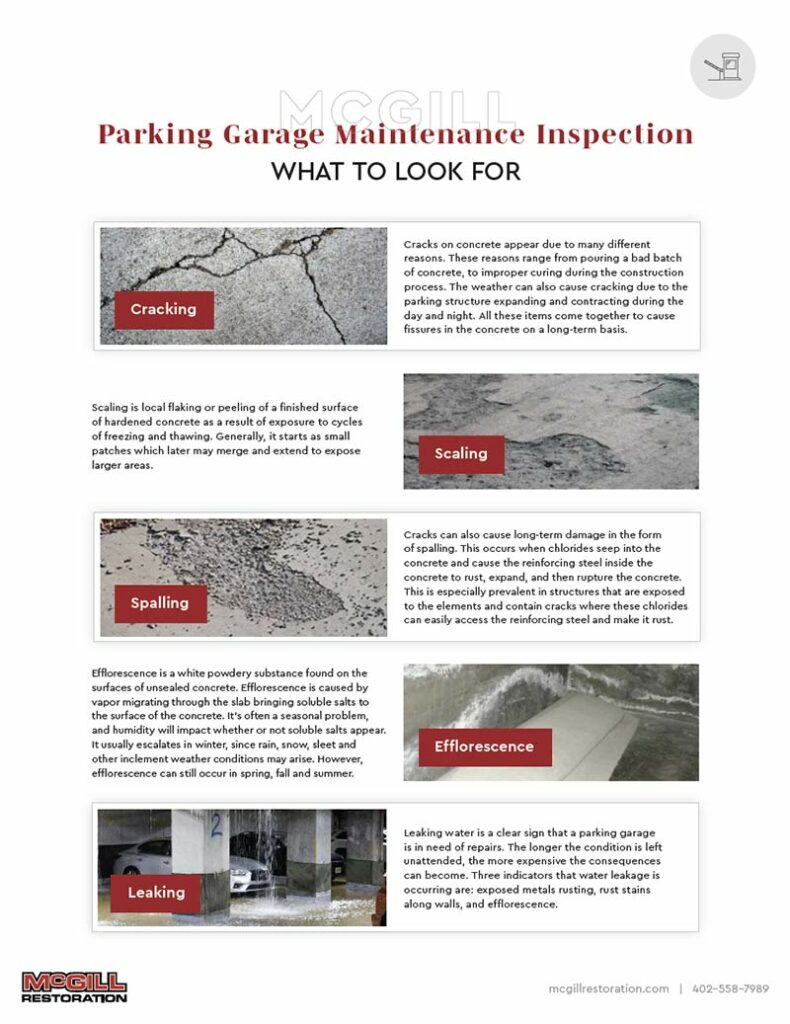Quality control and job site safety are both critical components of industrial restoration projects. Quality control is relative to the materials and processes used to safely maximize outcomes on every project. Safety guidelines and procedures protect the crew and public on and around active job sites. Both are at the forefront of planning and execution on every project for McGill Restoration.
Understanding Standardized Quality Control and Jobsite Safety
Quality control (QC) involves the selection and application of materials and repairs in a manner that ensures those elements are high quality and safety. Failing to use the proper materials and best practices can have catastrophic consequences. Generally, in industrial applications, a professional engineer will select materials.
For example, sourcing low-grade rebar and steel that doesn’t meet engineering specs and quality standards can fail load-bearing beams and ultimately a collapse and major accident. On a smaller scale, failing to select the proper industrial coatings or improper application methods can result in water damage and rapid decay of masonry where it should be protected for a decade. Quality control is essential for all materials selected and all construction processes.
Safety and QC overlap in many ways but safety is specific to protecting crew members and the public. Safety measures depend on the job and identify dangers that require standardized protocols for general safety.
OSHA is the federal regulatory body for safety and delivers guidelines and training for construction and job site safety. A few common standard safety measures include:
- Anything over 6 feet high requires a harness and tie-off for personnel
- Never lean ladders against walls
- High-visibility vests are required for road work
- Work boot, eye protection, and hard hats standards
There are plenty more and all employees complete mandatory training and certifications before working on projects in the field. Quality control standards also impact safety and vice versa. As an example, planning work in a tight space requires extensive discussion and preparations to ensure the right equipment and quality measures are possible while also implementing safety standards.
Our Approach to Quality Control and Jobsite Safety on Every Project
At McGill Restoration, we start with the mandatory standards and then overlay additional internal standards to reinforce and ensure the highest levels of quality control and safety on every single project.
Training – OSHA training is mandatory and we are always compliant but also strive to go the extra mile for safety. In the case that any additional training is relevant beyond the OSHA, state, and federal requirements, we invest in our team and put them through extra training and certification courses. Understanding the materials we work with and apply and the risks that accompany them are especially important in the industrial restoration space.
When our crews hit the job site, their proactive training and experience mean they know what the site should look like and how it should function to maximize safety and implement QC measures. This can include taking environmental readings to ensure the temperature, dew point, and other metrics are satisfactory for industrial coatings and other chemical products with very tight specifications.
Walkthroughs – Initial walkthroughs and planning are essential to both quality control and job site safety. Superintendents and foremen do walkthroughs to begin planning and assess what safety measures will be needed. Every project is different and taking an individualized approach to QC and safety helps us build a custom and highly effective approach. Stakeholders and other relevant parties are also looped into the walkthrough process because they know their facility better than anyone and that knowledge is invaluable.
Daily Jobsite Meetings – Every morning, our team meets before work commences at the job site. These meetings include daily job site safety assessments (JSAs) with the crew and a review of all materials to be used for the day. We log these meetings and discuss the tasks ahead for the day. In terms of quality control, we are frequently discussing material requirements, environmental, application methods, install materials, and conduct work alongside specific QC standards for all materials and processes scheduled.
Equipment Monitoring – Without well-maintained and functioning equipment, quality control and safety can suffer. We monitor and rigorously maintain every piece of machinery and equipment to ensure performance is optimized and efficient. This includes daily inspections on the job site prior to work, and strict preventative maintenance schedules on all equipment.
Record Keeping – Documentation is important and it creates a reference point for all quality control and safety measures taken daily. The daily meetings and JSAs are just one element of record-keeping. We also log environmental like temperature, dew point, hazardous emissions, or air monitoring results as relevant to each job.
A Closer Look at Our Internal Safety Standards and Training
We are busy with projects and that means safety and training are built into our process. This ensures consistency and a dedicated focus on safety. We conduct many of our safety training sessions and workshops during the winter months when projects are slower, and the crew can dedicate time to safety and craftsmanship training. Our experienced crew members use this opportunity to refresh and renew certifications while newer crew receive formal training on craftsmanship skills, specialized materials, and safety.
A few McGill Restoration safety training include:
- Fall Safety Training – This training is critical to the success of most restoration projects. In this training we cover proper harness use, anchors, tie-offs and ratings for harness types. We also work through arrest systems and restraints, strategies to help alleviate harness pressure that cuts off circulation in a fall situation, and rescue plans/procedures.
- Confined Spaces – Working in an area with a restricted entry is dangerous and requires certified personnel to complete it. We train on confined space entry, communications, harness operations, responding to injury or illness, potential hazards, and air monitoring. We also train confined space operators in the development of rescue plans which can be vital in an emergency.
- Fit Training – We work through half- and full-mask procedures, dust protection, the filter uses, and the equipment that protects you from dust and air particulates on job sites.
- Equipment Checks – Knowing how equipment works and the checklist for each machine are covered in this training. We also stress proper field maintenance from greasing equipment to clearing clogs and cleaning spray equipment, we run through it all.
Approaching Public Safety on Construction and Restoration Jobsites
Safety isn’t all crew oriented, and the public is adjacent to many job sites. In some instances, like our consistent DOT work, live traffic calls for safety measures to route traffic and build barriers between crew members and the public. In other instances, like our work on the Syngenta Crop Protection Plant, containment measures to protect the public from dust and debris fallout are required.
Public safety is priority number one and every job site is thoroughly planned and reviewed to account for all risks while ensuring public safety is maintained throughout the project duration. A few common safety protocols to protect the public include:
- Cones and signage to indicate work zones and detours
- Vacuum and ventilation equipment to manage airflow, removing dust and particulates from interior spaces
- Off-hours work scheduling for public convenience
- Educational materials regarding the proper use of chemicals
Every McGill Restoration job site has an individualized approach that accounts for public safety, going above and beyond required mandates to prioritize safety.
Working with Construction and Restoration Partners on Complex Projects
McGill Restoration isn’t alone on many job sites and other contractors and subcontractors are frequently working in overlapping spaces. These situations are more complex and they call for additional attention to quality control and safety measures.
General Contractor Role – When McGill Restoration is the general contractor on a project, all subcontractors must adhere to our highest QC and safety standards. We communicate this clearly and loop folks into training and documentation processes.
Subcontractor Role – [can link to subcontractor/480 case study when published] When we’re working as a subcontractor, roles are a bit different but not by much. If we find a general contractor with stricter safety standards, like using harnesses at 4 feet vs. 6 feet, we adhere to the higher standard of safety. We still implement our established QC procedures. We never fall below our internal requirements for safety and quality control.
Safety in Action: Examples from McGill Restoration Projects
We have a long list of examples but a few jobs stand out. We are proud of the results and our exceptional track record on safety and quality control across all projects.
Rice tank job – Lincoln Electric System (LES) Rice Tank required sandblasting and coating at a natural gas plant. It was a difficult job on a 60-foot tall by 150-foot wide tank, requiring extra safety measures for success. We prepared for the worst and collaborated with ownership and Lincoln Fire & Rescue to develop a confined space rescue plan.
On this project, we:
- Built scaffolding to safely complete all work
- Implemented mandatory respirator requirement and evac system to maintain air quality and meet material environmentals
- Implemented confined space and extraction plan designed for the entire team and local fire officials
Cheerio Apartments – We completed balcony and stairwell restoration to this apartment complex while protecting tenants and strategically placing equipment to mitigate risk. Without structural steel repair, tenants would have been placed at risk. In fact, at the Tranquility apartments in Lincoln, ownership waited too long to replace failing balconies, and tenants on the upper levels were forced to leave while a full replacement was constructed.
On this project, we:
- Implemented fall safety while working above ground
- Maintained a clean, contained, and safe worksite to protect residents
- Braced and contained overhead hazards
I-480 DOT Project– Working on roadways and especially on elevated bridges is hazardous to crew members and the public. We can’t control public drivers and that makes it critical to isolate and shield crews from live traffic. On the I-480 DOT project, work was not only adjacent to live traffic, it was also done on elevated bridges with active traffic below.
On this project we:
- Positioned equipment as barricades to shield crew members from live traffic
- Designed signage and cones for clear traffic directions
- Created debris containment and catchment to protect the public below bridges
- Adhered to all OSHA and DOT safety standards
The bottom line, construction, and restoration companies must raise and keep the bar high regarding job site safety and quality control. McGill Restoration always prioritizes and beyond safety measures and quality control procedures.
Ultimately, we want everyone to go home safely at the end of the day to enjoy their families and lives. We also love seeing our work standing tall and strong for the long haul because it was completed with the highest levels of quality control.
Don’t risk it. Contact McGill Restoration for best-in-class quality control and job site safety standards on your next commercial restoration project.



